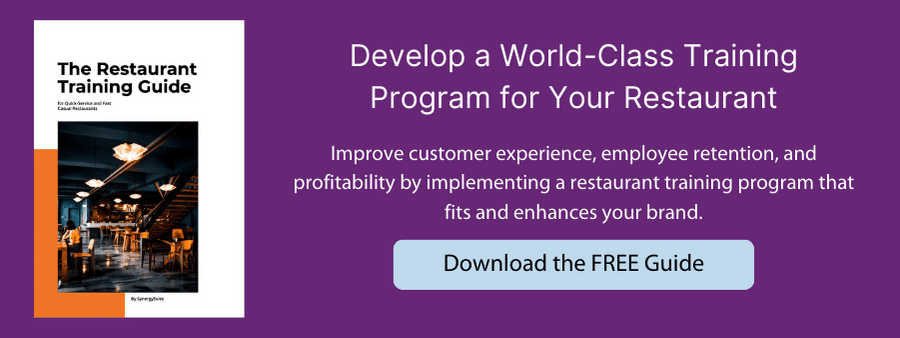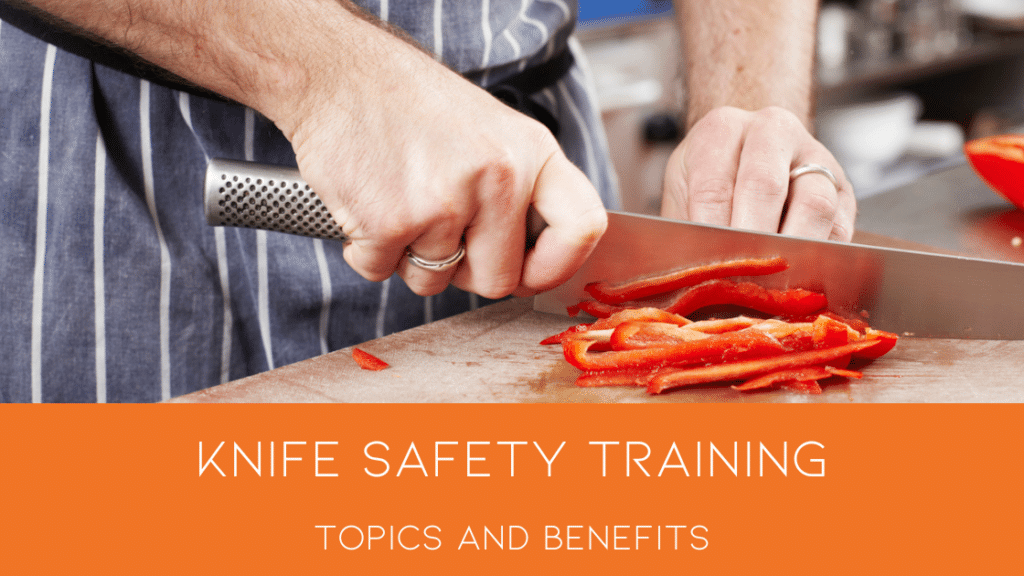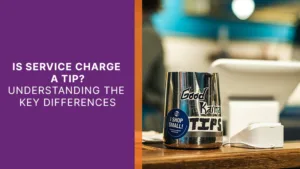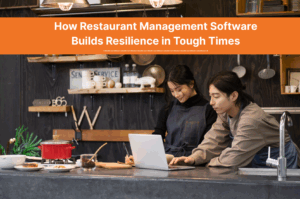Updated on: May 24, 2023
If you work in a restaurant, you’re guaranteed to be around knives. While a quality knife is a valuable tool, it also inherently carries risks to the user and those around them. In this article we’ll go over knife safety training in the restaurant: what it is, why you should care, and what you should cover in your restaurant training program.

What is Knife Safety Training?
Knife safety training encompasses the proper use, storage, cleaning, and maintenance of anything that can be considered a knife, from an actual chef’s knife, to a food slicer, to a box or utility knife, and more.
A great knife safety training program covers all the aspects of owning and using a knife. Because the knife is so essential to restaurant workers, it should be something that every team member is intimately familiar with. This includes not just how to be as safe as possible with a knife, but also how to maintain it, sharpen it, and store it properly.
Why is Knife Safety Training Important?
Knife safety training has some obvious safety benefits, but there are other reasons to incorporate a solid knife safety training program in your restaurant business. Here are some of the biggest benefits of incorporating a knife safety program.
- It helps to avoid injuries and accidents – While this is a no-brainer, it’s also absolutely the biggest benefit for knife safety training. The safety of your employees should be your number one priority.
- It increases efficiency – Proper knife safety and handling training will help your team know how to handle and use their knives. With practice, the knife then becomes an efficient tool that allows them to complete tasks properly and quickly.
- It decreases costs – Knife safety training can significantly decrease the costs to your restaurant, most notably your insurance and injury compensation costs. In addition, proper knife maintenance can decrease the cost of replacing equipment that is in poor condition or disrepair.
- It increases employee trust – A solid knife safety training program is a great way to show your employees that you care about them. The more you put proper safety procedures in place, the more they will trust the way you treat them. In addition, it enables your team to trust each other, and feel safe working together.
Is Knife Safety Training Required by Law?
As of now, knife safety training is not regulated or required by law in any states or provinces in the U.S. or Canada. However, in the United States, OSHA’s General Duty Clause does require all employers to provide safety measures for a workplace that is free of hazards.
Each country, state, or province will have its own requirements and regulations, so make sure to check with your local government agencies for the most up-to-date information.

What Should Knife Safety Training Include?
Using the Right Knife for the Job
A proper knife safety training program should provide orientation on the different types of knives that your staff might be using, and what each should be used for. In a kitchen, the collection of knives can be quite extensive, and used for a wide variety of purposes. It’s always safest to use the right knife for the job.
Here are some of the most common knives that would be used in a food service establishment.
- Chef’s Knife: The chef’s knife is the most versatile and widely used knife in the arsenal. It can handle most of the common tasks required, from chopping to dicing to a quality julienne, this knife is the swiss army knife of the kitchen.
- Paring Knife: A paring knife is generally a smaller version of a chef’s knife and is used for the more fine-tuned tasks, like slicing or mincing vegetables or garlic.
- Santoku Knife: The santoku knife is a mid-to-large sized knife that is generally used for slicing, dicing, and chopping vegetables.
- Serrated Knife: A serrated knife is any knife that doesn’t have a smooth edge, and instead has sharp points along the cutting surface. One common serrated knife is a bread knife, but generally they’re best at cutting items that have a harder exterior, but soft interior. This could include things like tomatoes, sausages, melons, and more.
- Utility Knife: Utility knives are certainly not used for cutting food, but can be quite helpful when receiving, repackaging, and storing food that may be delivered in boxes. Using a proper utility knife is a much better option than opening boxes with your kitchen knives.
Knife Sharpening and Honing
Contrary to what an inexperienced cook might think, the sharper the knife, the safer it can be. This is because a sharper knife is less likely to slip and cause an accident. Sharper knives also make knife handling more efficient and better performing, and increases the life of the knife. A sharper knife also makes cleaner cuts, which reduces the amount of bacteria and other contagions that might try to make their way into your food.
Knowing how to properly sharpen and hone a knife is essential to the proper care of your kitchen knives. However, this task should not be taken lightly, and should be taken care of by someone that has the proper experience. Either you can ensure that each of your employees is trained appropriately, or you can hire a professional to do the sharpening and honing for you.
Knife Cleaning and Maintenance
The proper training in the cleaning of knives between each use doesn’t just promote food safety, but also helps to avoid injuries during the cleaning process. Regular knife cleaning removes any food particles or debris that can cause negative effects, such as corrosion, rusting, or other potential damage to the knife.
Your knife safety training should include the proper procedure for cleaning knives. As an added bonus, proper knife cleaning also maintains the look and feel of the knives, for a better aesthetic.
Proper Cutting Techniques
After your team has become familiar with their knives and how to clean and maintain them, they should also know how to handle them. It’s not enough to use the right knife for the job if you don’t know how to do the job properly.
Your knife safety training should also include the proper and safe handling of your knives. Depending on your menu, there may be just a few required cutting techniques, or there could be a long list. Demonstrate each technique and allow your team to practice them regularly to ensure that the job is well done, and that each employee feels safe executing each technique.
Here are some of the most common techniques:
- Slicing: This technique involves holding the food steady with one hand while using the other hand to make long, smooth, and even cuts. This technique is commonly used for meats, fish, and vegetables.
- Dicing: This technique involves cutting food into small, evenly-sized cubes. The food is first sliced, then stacked and cut into small cubes. This technique is commonly used for vegetables and fruits.
- Chopping: This technique involves using a rocking motion to chop food into small pieces. This technique is commonly used for herbs, onions, and garlic.
- Mincing: This technique involves using a rocking motion to chop food into very small pieces. This technique is commonly used for garlic, ginger, and shallots.
- Julienne: This technique involves cutting food into thin strips, typically about 2-3 inches long and 1/8 inch wide. This technique is commonly used for vegetables and fruits.
- Brunoise: This technique is similar to dicing, but the cuts are even smaller, typically about 1/8 inch cubes. This technique is commonly used for vegetables, fruits and herbs.
- Batonnet: This technique is similar to Julienne, but the cuts are even bigger and thicker, typically about 1/4 inch thick and 2 inches long.
The type of cutting technique used will play a role in the way the food is prepared, as well as presented to customers.
Awareness of Surroundings
Proper knife safety training includes constant reminders to be aware of surroundings. Anyone using a knife should be in a safe place where it is unlikely for them to be bumped or interrupted by others. Adding a step to the process that requires the employee to pay attention to what’s around them is a good idea for any knife handling task.
Once the surroundings have been accounted for, the employee is then able to focus on what they’re doing. A large percentage of knife accidents happen as a result of the user losing focus on what they’re doing, and just accidentally cutting themselves. Consistent reminders to be aware of what’s going on, and also focus on what they’re doing, essential to proper knife safety.
Proper Knife Storage
Proper knife storage is an important topic in knife safety training. Improperly stored knives can appear in the worst places, and cause injury to anyone who is unaware of them. There are several options when it comes to proper storage of knives in a restaurant, and the right approach may depend on whether the employees are responsible for their own knives, or whether the knives are part of the kitchen equipment.
Here are some of the ways knives can be safely stored in your restaurant:
- Use a knife rack or magnetic strip: A knife rack or magnetic strip is a safe and convenient way to store knives. The knives are kept in an upright position, which makes it easy to grab the one you need, and it also keeps the knives away from other kitchen tools and equipment.
- Use a knife block: A knife block is another safe and convenient way to store knives. The knives are kept in a vertical position, which makes it easy to grab the one you need, and it also keeps the knives away from other kitchen tools and equipment. However, if there are many knives to be used all the time, it may be cumbersome to have multiple knife blocks taking up room on your counter space.
- Use a knife bag, roll, or case: A knife bag, roll, or case is a great option for transporting knives to and from work, and is generally the preferred option if employees are responsible for their own knives. It’s also a good option for storing knives when not in use, it keeps them safe from damage and can be more hygienic.
- Use a knife drawer: A knife drawer is an option for storing knives when not in use, it generally keeps them safe from damage, though sometimes having a lot of knives in a drawer can cause nicks and scratches. It’s also a good way to keep the knives out of reach of children and untrained staff.
- Store knives separately: Knives should be stored separately from other kitchen tools and equipment to avoid damage and cross-contamination.
Basic First Aid
Even with the best knife safety training procedures in place, accidents are bound to happen anyway. Your training program should ensure that everyone who is handling knives knows what to do when something does go wrong. Ensure that everyone knows where the first aid kit is, and can properly clean and dress wounds. In severe cases, they should also know who to call and how to handle situations when an employee is hurt badly enough that they can’t continue working.
Accident Reporting Procedures
When accidents do happen, your human resources department should definitely know about it. In most states, all knife accidents that occur are required to be reported to the appropriate authorities. Additionally, many states require the employers to report any accidents resulting in lost work time, no matter how minor the injury is.
It’s important to have proper accident reporting systems and procedures in place in your food service business, and that your employees know how to work through them. This will be vital to the efficient management of any compensation or insurance claims that may result in knife accidents. In addition, it’s also important to document the incident, in order to prevent similar accidents in the future, and to have a clear record of what happened in case of any liability issues.
It’s worth noting that failure to report a workplace accident can result in penalties and fines, it’s also important to have the appropriate insurance coverage in case of accidents and liability issues.
Streamline Knife Safety Training with Restaurant HR Software
When working within a restaurant enterprise with many locations, you can save yourself a lot of time and effort during restaurant employee training by utilizing restaurant HR software. This software can be incredibly useful for keeping updated versions of your manuals, videos, and other resources in a place that can be accessed and referenced from anywhere and at any time.
Not only that, but restaurant HR software can also help you create onboarding and training documents and checklists that will ensure that each employee is up-to-date on their training, and that no important topics are missed. This can be especially useful when you are managing the training of new employees across a large number of locations, saving your HR department a lot of time and energy in tracking the progress of each new employee.






